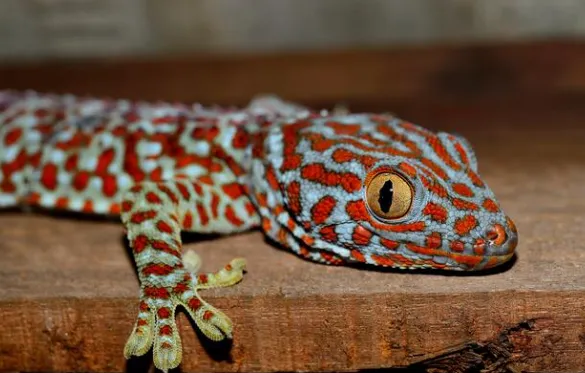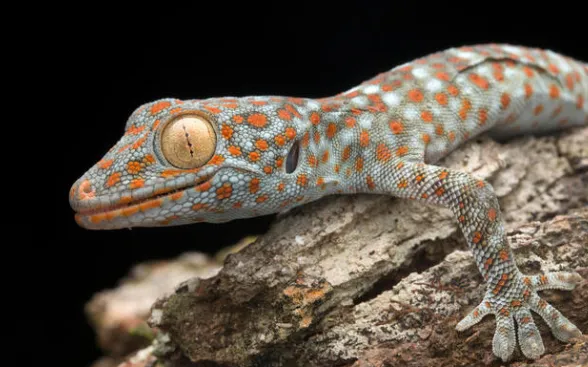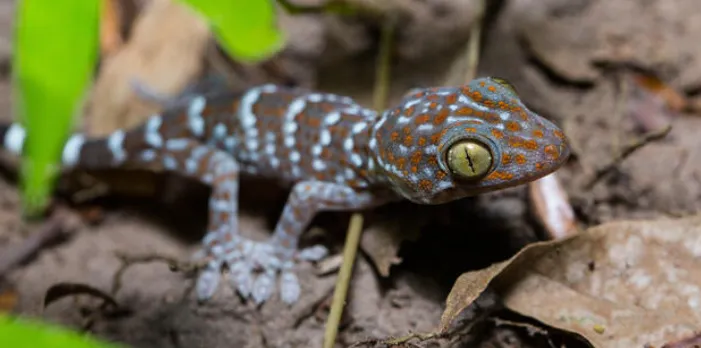
Table of Contents
Diet
Q: What do tokay geckos eat in the wild?
A: In the wild, tokay geckos are opportunistic predators. They mainly feed on various insects, spiders, smaller lizards, and even small mammals and birds on occasion.
Q: What can I feed my captive tokay gecko?
A: Captive tokay geckos thrive on a diet of crickets, roaches, mealworms, waxworms, and other commercially available feeder insects. Occasionally, they can also be given small pinky mice.
Q: How often should I feed my tokay gecko?
A: Young tokay geckos should be fed daily, while adults can be fed every other day or three times a week.
Q: Can tokay geckos eat fruits and vegetables?
A: While their primary diet consists of insects and other prey, tokay geckos might occasionally consume fruits or vegetation in the wild. In captivity, it’s not essential to offer fruits and veggies, but they can be given as occasional treats.
Q: Do tokay geckos need live insects in their diet?
A: Yes, tokay geckos are insectivorous and require live prey to stimulate their hunting instincts. Live insects provide essential nutrients and mental stimulation for them.
Q: How much
A: A general rule is to offer 2-5 appropriate-sized insects per feeding session, depending on the gecko’s size and age. Monitor their weight and adjust as necessary.
Q: What insects are safe for tokay geckos?
A: Crickets, roaches, mealworms, and waxworms are all safe. Ensure they are appropriately sized, with the insect’s size not exceeding the space between the gecko’s eyes.
Q: Do I need to supplement my tokay gecko’s diet with vitamins and minerals?
A: Yes. It’s essential to dust the insects with calcium and vitamin D3 powder to ensure proper bone health and overall well-being. Additionally, a multivitamin supplement can be offered once a week.
Q: Should I dust the insects with calcium before feeding them to my tokay gecko?
A: Absolutely. Calcium supplementation is crucial to prevent metabolic bone disease and other health issues.
Q: Why is my tokay gecko refusing
A: There could be several reasons: stress, incorrect cage temperatures, illness, or shedding. If the refusal persists, consult a veterinarian.
Q: Can I feed my tokay gecko pinky mice?
A: While they can eat pinky mice, it should be given sparingly, perhaps once a month, as too much can lead to obesity.
Q: How do I provide water for my tokay gecko?
A: Provide a shallow dish of fresh water, and also mist the enclosure regularly. Tokay geckos often drink water droplets from their environment.
Q: Are there any specific foods that are toxic to tokay geckos?
A: Avoid feeding wild-caught insects as they might have been exposed to pesticides. Also, avoid giving them fireflies, which are toxic to many lizards.
Q: How can I ensure the insects I offer are nutritious?
A: “Gut-load” the insects by feeding them a nutritious diet for 24-48 hours before offering them to your gecko. This ensures they pass on essential nutrients.
Q: Can tokay geckos eat mealworms or waxworms?
A: Yes, but they should be given in moderation. Waxworms, in particular, are high in fat and should be given as an occasional treat.

Habitat
Q: What type of enclosure do tokay geckos need?
A: Tokay geckos thrive in vertically oriented, well-ventilated enclosures due to their arboreal nature. Glass terrariums with mesh tops are ideal as they allow for adequate ventilation and easy observation.
Q: How large should a tokay gecko’s
A: For a single adult tokay gecko, a 20-gallon tall terrarium is recommended. If housing multiple geckos, a larger space is necessary to prevent territorial disputes.
Q: What’s the best substrate for a tokay gecko?
A: Coconut coir, orchid bark, or cypress mulch work well as they retain moisture and maintain humidity while being safe if accidentally ingested.
Q: Do tokay geckos require UVB lighting?
A: While they can survive without UVB due to their nocturnal nature, providing a low-level UVB light can be beneficial for their overall health and calcium metabolism.
Q: How do I regulate the temperature in a tokay gecko’s habitat?
A: Employing a ceramic heat emitter or under-tank heating pad can help maintain a temperature gradient. The warm end should be between 85-90°F, while the cool end should stay around 70-75°F.
Q: How often should I clean my tokay gecko’s terrarium?
A: Spot clean the terrarium daily for feces or uneaten
Q: What’s the ideal humidity level for a tokay gecko?
A: Tokay geckos thrive in 70-80% humidity. This can be achieved by misting the enclosure daily and using moisture-retaining substrates.
Q: How can I provide the necessary humidity for my tokay gecko?
A: Misting the enclosure daily, providing a water dish, and using a substrate like coconut coir that retains moisture can help maintain high humidity levels.
Q: What plants are safe and recommended for tokay gecko enclosures?
A: Both live and artificial plants like pothos, snake plants, or bromeliads can be used. They provide hiding spots and maintain humidity.
Q: Can I house multiple tokay geckos in one
A: It’s generally not recommended due to their territorial nature. If attempted, the
Q: Do tokay geckos need a basking spot?
A: Yes, while they are nocturnal, they can benefit from a basking spot that reaches about 85-90°F.
Q: What kind of hides or decorations should be in a tokay gecko’s terrarium?
A: Cork bark, branches, and both live or artificial plants can offer climbing opportunities and hiding spots.
Q: Are there specific materials to avoid in a tokay gecko’s habitat?
A: Avoid using sand or calcium-based substrates as these can cause impaction if ingested. Also, avoid sharp or rough decorations that can injure the gecko.
Q: How to set up a bioactive habitat for tokay geckos?
A: Incorporate a drainage layer, a substrate layer (like coconut coir), and then add live plants, isopods, and springtails. This creates a self-cleaning, naturalistic environment.
Q: Can I use sand or loose substrate for my tokay gecko?
A: It’s best to avoid sand or loose substrates, as they can lead to impaction if ingested.
Q: How do I provide water for my tokay gecko?
A: Offer a shallow water dish and mist the enclosure daily. Geckos often drink water droplets from the misting.
Q: What are the signs of an ideal tokay gecko habitat?
A: An ideal habitat has proper temperature and humidity gradients, a variety of hiding and climbing spots, and a clean, safe substrate.
Q: Are there any plants or substrates toxic to tokay geckos?
A: Some plants, like philodendrons or dieffenbachia, can be toxic. It’s essential to research plants before adding them to the enclosure. Also, avoid sand or calcium-based substrates.
Q: How do I monitor and control ventilation in a tokay gecko’s habitat?
A: Mesh-top terrariums naturally provide good ventilation. Ensure the enclosure is not placed in a drafty area, and monitor humidity levels to ensure they don’t drop too low.
Q: How to mimic the tokay gecko’s natural habitat in captivity?
A: Use naturalistic substrates, add vertical climbing structures, maintain appropriate temperature and humidity levels, and provide a combination of live and artificial plants to resemble their natural forested environments.

Behavior
Q: Why is my tokay gecko so aggressive?
A: Tokay geckos have a natural defensive behavior in the wild, making them more aggressive or defensive when compared to other pet geckos. Their aggressiveness is a mechanism to deter potential threats.
Q: Is it normal for tokay geckos to vocalize?
A: Yes, tokay geckos are known for their distinctive calls or vocalizations, which is where their name “tokay” originates from. They may vocalize for various reasons, including mating calls, defending territory, or feeling threatened.
Q: Do tokay geckos bite?
A: Yes, tokay geckos can and do bite, especially when they feel threatened. Their bite can be quite strong, so always handle with care.
Q: How can I tame my tokay gecko?
A: Taming a tokay gecko requires patience and consistent, gentle handling. Start with short sessions and gradually increase the time as the gecko becomes more accustomed to your presence. Avoid making sudden movements and approach them calmly.
Q: Are tokay geckos nocturnal?
A: Yes, tokay geckos are primarily nocturnal, meaning they are most active during the night and tend to rest or hide during the day.
Q: Why is my tokay gecko hiding all the time?
A: Tokay geckos are naturally secretive creatures. If they’re hiding, it could be due to the daytime (natural behavior) or potentially due to stress, incorrect habitat conditions, or feeling threatened.
Q: How do tokay geckos communicate?
A: Tokay geckos communicate primarily through vocalizations and body language. The characteristic “tokay” call, for example, is a form of communication. They also use body movements, such as tail waving or puffing up, to signal different emotions or intentions.
Q: Can tokay geckos be housed together?
A: It’s generally not recommended to house multiple tokay geckos together, especially males, as they can become territorial and aggressive towards each other. If you do house them together, ensure the enclosure is spacious with multiple hides.
Q: Why does my tokay gecko puff up?
A: Puffing up is a defensive behavior in tokay geckos. They do this to appear larger and more intimidating when they feel threatened.
Q: Do tokay geckos recognize their owners?
A: While tokay geckos might not recognize owners in the same way mammals do, they can become accustomed to their keeper’s presence and handling routines over time.
Q: Is it normal for tokay geckos to drop their tail?
A: Yes, like many gecko species, tokays have the ability to drop their tails as a defense mechanism against predators. The tail will regenerate over time, though it might not look exactly like the original.
Q: Why is my tokay gecko not eating?
A: There could be various reasons, from stress, incorrect habitat conditions (temperature, humidity), illness, or even natural behavior during certain periods like breeding or brumation.
Q: How active should a tokay gecko be?
A: Tokay geckos are most active during the night. If provided with a suitable environment and proper care, they should be actively exploring, hunting, and displaying natural behaviors during these hours.
Q: Why does my tokay gecko lick its surroundings?
A: Geckos often lick their surroundings to gather information about their environment, similar to how snakes use their tongue to “taste” the air. It’s a natural exploratory behavior.
Q: Can I handle my tokay gecko?
A: While it’s possible to handle tokay geckos, they tend to be more aggressive and less tolerant of handling than other gecko species. It’s crucial to approach them gently and patiently to minimize stress.
Q: Why is my tokay gecko chirping at night?
A: Chirping can be a form of communication, signaling anything from contentment to a mating call or even a sign of stress or discomfort.
Q: Are tokay geckos territorial?
A: Yes, especially males. They can be quite territorial and may exhibit aggressive behavior towards other geckos if they feel their space is being invaded.
Q: How can I tell if my tokay gecko is stressed?
A: Signs of stress in a tokay gecko can include excessive hiding, refusal to eat, aggressive behavior, rapid breathing, or frequent attempts to escape the enclosure.
Q: Do tokay geckos show any signs of breeding behavior?
A: Yes, during the breeding season, male tokay geckos might become more vocal, and females might become more reclusive. Males might also show increased territorial behavior.
Q: Why does my tokay gecko keep climbing the glass of its enclosure?
A: Climbing the glass, often referred to as “glass surfing,” can be a sign of stress, boredom, or discomfort. Ensure the habitat conditions are optimal and provide ample hides and climbing opportunities inside the enclosure.

Health and Wellness
Q: Do tokay geckos have specific health concerns compared to other geckos?
A: Yes, while many health concerns are common across gecko species, tokay geckos, due to their larger size and more aggressive nature, can be prone to stress-induced ailments, especially if not handled properly or if their habitat is inadequate.
Q: How can I tell if my tokay gecko is sick or stressed?
A: Signs of illness or stress can include lethargy, loss of appetite, irregular shedding, labored breathing, or any visible injuries. Changes in behavior, like prolonged hiding or aggression, can also indicate stress.
Q: Why is my tokay gecko not eating?
A: There are various reasons: it could be due to stress, an unsuitable environment (incorrect temperature or humidity), illness, or shedding. If the appetite doesn’t return within a week or is accompanied by other concerning symptoms, consult a veterinarian.
Q: What are the signs of a respiratory infection in tokay geckos?
A: Symptoms include wheezing, labored breathing, excessive mucus around the mouth or nose, and a lack of appetite. If you notice these signs, seek veterinary care promptly.
Q: How often should tokay geckos shed their skin?
A: Young tokay geckos might shed once every few weeks, while adults will shed less frequently, approximately once every 4-6 weeks. Regular, healthy shedding is a good sign of proper care and nutrition.
Q: Can tokay geckos get mites or parasites, and how are they treated?
A: Yes, like other reptiles, tokay geckos can get external mites or internal parasites. Treatment includes anti-parasitic medications and thorough cleaning of the habitat. Always consult a vet for appropriate treatment.
Q: Is it normal for tokay geckos to drop their tails?
A: While tokay geckos can drop their tails as a defense mechanism, they won’t regrow it as fully as some other gecko species. Tail dropping can be a result of stress, handling, or a perceived threat.
Q: How can I safely handle my aggressive tokay gecko during health checks?
A: Approach slowly and confidently, using gloves if necessary. Handling should be minimized to reduce stress, especially if they’re not accustomed to human interaction.
Q: What is the ideal weight or size for a healthy tokay gecko?
A: Adult tokay geckos can range from 8 to 12 inches in length and weigh between 50-150 grams. Regular weigh-ins can help monitor health.
Q: Do tokay geckos need specific supplements or vitamins in captivity?
A: Yes, they require calcium and vitamin D3 supplements to prevent metabolic bone disease. Gut-loading their prey and occasional vitamin supplementation can also be beneficial.
Q: How can I ensure my tokay gecko is hydrated?
A: Provide fresh water in a shallow dish and mist the enclosure regularly. Monitoring the humidity and ensuring it remains within the ideal range is also crucial.
Q: What are signs of metabolic bone disease in tokay geckos?
A: Symptoms include weak or rubbery limbs, difficulty moving, a kinked spine, and a swollen or underbite jaw. Proper UVB lighting and calcium supplementation can prevent this condition.
Q: Can tokay geckos get fungal or skin infections?
A: Yes. Symptoms include discolored patches, blisters, or sores. Proper habitat cleaning and avoiding excessive humidity can prevent these issues. Consult a vet for treatment.
Q: How do I treat cuts or wounds on my tokay gecko?
A: Clean the wound with a reptile-safe antiseptic and keep the habitat clean. If the wound is deep, doesn’t heal, or gets infected, see a veterinarian.
Q: Why are my tokay gecko’s eyes cloudy or shut?
A: This can indicate an upcoming shed, an eye infection, trauma, or a vitamin A deficiency. If the issue persists post-shed or if there’s noticeable discharge, seek vet care.
Q: Are there common mouth diseases in tokay geckos, and how can they be treated?
A: Mouth rot, or stomatitis, is a common ailment that presents as redness, swelling, or pus in the mouth. Treatment typically requires antibiotics and antiseptic cleaning under veterinary guidance.
Q: How do I care for a gravid (egg-bearing) female tokay gecko?
A: Ensure she has a suitable nesting area filled with moist substrate. Increase her calcium intake and monitor her for any signs of distress. Post-laying, check her health and weight.
Q: Is it normal for tokay geckos to vocalize or make loud noises?
A: Yes, tokay geckos are known for their vocalizations, which can be a sign of stress, territorial disputes, or mating behavior.
Q: How often should I get my tokay gecko checked by a veterinarian?
A: An annual check-up is recommended. However, if you notice any signs of illness or unusual behavior, schedule a visit sooner.
Q: How can I set up a quarantine for new tokay geckos to ensure they are healthy?
A: Set up a separate, simple enclosure with the essentials. Quarantine new geckos for at least 30 days, monitoring for signs of illness. Ensure you handle quarantined animals last to avoid cross-contamination.
- Enchi Ball Python: A Unique and Stunning Morph of Python regius - March 27, 2025
- Emerald Tree Monitor: The Enigmatic Green Guardian of the Rainforest - March 26, 2025
- The Egyptian Cobra (Naja haje): A Fascinating Serpent - March 25, 2025
